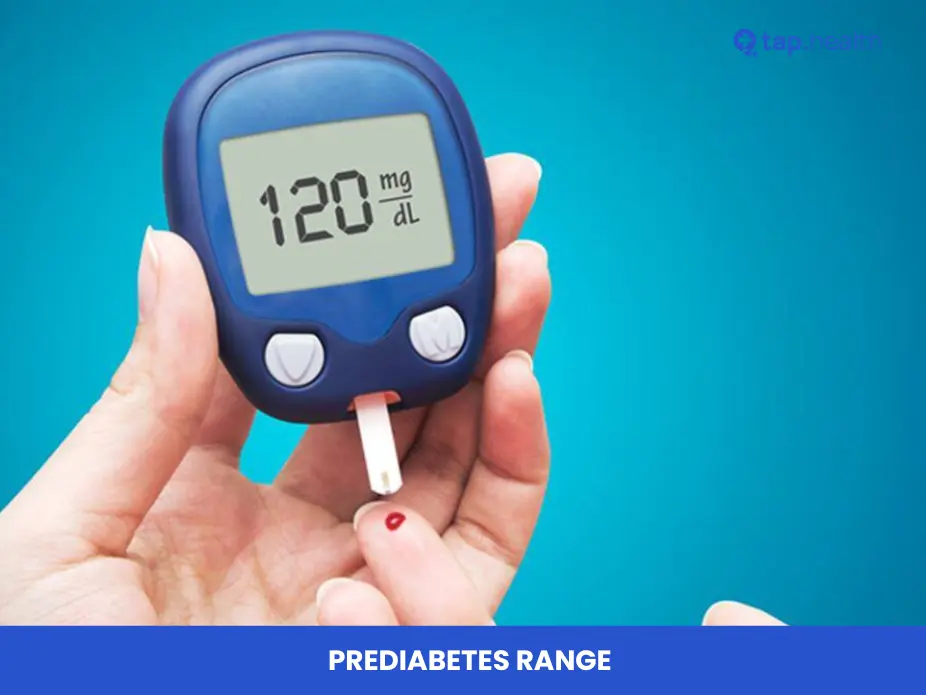Prediabetes is a critical health condition that indicates your blood sugar levels are higher than normal but not yet high enough to be classified as type 2 diabetes. Understanding the prediabetes range is essential for early detection and prevention of more severe health issues. This blog will delve into what prediabetes is, how it’s diagnosed, the specific ranges, and effective steps you can take to manage or reverse it.
What Is Prediabetes Range?
The prediabetes range refers to blood sugar levels that are elevated above the normal range but have not yet reached the threshold for a diabetes diagnosis. This stage acts as a warning sign, indicating that your body is beginning to struggle with blood sugar management. Recognizing this range early allows you to implement lifestyle changes that can prevent the progression to type 2 diabetes.
Key Points:
- Elevated Blood Sugar: Blood sugar levels are higher than normal but not high enough for diabetes.
- Warning Sign: Indicates potential future health issues if not addressed.
- Opportunity for Change: Early detection allows for preventive measures.
Aldo read this- Is Type 2 Diabetes Reversible?
How Is Prediabetes Range Diagnosed?
Diagnosing the prediabetes range involves several tests that measure your blood sugar levels. Here are the most common methods:
1. Fasting Plasma Glucose Test (FPG)
This test measures your blood sugar after an overnight fast. A fasting blood sugar level between 100-125 mg/dL is considered prediabetes.
2. Hemoglobin A1c Test
The A1c test provides an average of your blood sugar levels over the past three months. An A1c result between 5.7% and 6.4% falls within the prediabetes range.
3. Oral Glucose Tolerance Test (OGTT)
This test measures your blood sugar before and two hours after you drink a sugary beverage. A two-hour blood sugar level between 140-199 mg/dL indicates prediabetes.
Why These Tests Matter:
- Early Detection: Identifies elevated blood sugar levels before diabetes develops.
- Guides Treatment: Helps healthcare providers recommend appropriate interventions.
- Monitors Progress: Tracks changes in blood sugar levels over time.
What’s the Prediabetes Range?
Understanding the specific prediabetes range helps in identifying where you stand and what steps to take next. The ranges vary depending on the type of test conducted:
- Fasting Blood Sugar: 100-125 mg/dL
- Hemoglobin A1c: 5.7% – 6.4%
- Oral Glucose Tolerance Test: 140-199 mg/dL after two hours
Importance of Knowing Your Range:
- Personal Awareness: Helps you understand your risk level.
- Preventive Action: Encourages timely lifestyle changes.
- Medical Guidance: Assists doctors in creating a management plan.
Prediabetes Range Chart
| Test Type | Prediabetes Range |
|---|---|
| Fasting Plasma Glucose (FPG) | 100-125 mg/dL |
| Hemoglobin A1c (HbA1c) | 5.7% – 6.4% |
| Oral Glucose Tolerance Test | 140-199 mg/dL after 2 hours |
This chart provides a quick reference to understand where your blood sugar levels stand concerning prediabetes.
Why These Numbers Matter
These ranges help doctors identify individuals at risk of diabetes. By recognizing where your numbers fall, you can take steps to manage your blood sugar levels effectively.
Simple Steps to Control Prediabetes Range
Managing your prediabetes range involves adopting healthy habits that can significantly reduce your risk of developing type 2 diabetes. Here are some simple steps to help you control your blood sugar levels:
1. Adopt a Balanced Diet
Focus on eating a variety of fruits, vegetables, whole grains, lean proteins, and healthy fats. Limit sugary snacks and beverages, and reduce your intake of processed foods.
2. Increase Physical Activity
Aim for at least 150 minutes of moderate exercise each week, such as brisk walking, cycling, or swimming. Incorporate strength training exercises to build muscle mass, which helps your body use insulin more effectively.
3. Maintain a Healthy Weight
Losing even a small percentage of your body weight can make a significant difference. Strive to lose 5-10% of your current weight through diet and exercise.
4. Monitor Your Blood Sugar Levels
Regularly checking your blood sugar can help you understand how your body responds to different foods and activities. This can guide your lifestyle choices to better manage your blood sugar.
5. Limit Sugar and Refined Carbs
Reduce your intake of sugary drinks, candies, and refined carbohydrates like white bread and pasta. Opt for whole grains instead, which have a lower impact on your blood sugar.
6. Stay Hydrated
Drinking plenty of water helps your kidneys flush out excess sugar and keeps you feeling full, reducing the likelihood of overeating.
7. Get Adequate Sleep
Aim for 7-9 hours of quality sleep each night. Poor sleep can affect your hormones and increase your risk of insulin resistance.
Benefits of These Steps:
- Improved Blood Sugar Control: Helps keep your blood sugar levels within the prediabetes range.
- Weight Management: Reduces the risk of progressing to type 2 diabetes.
- Overall Health: Enhances your general well-being and reduces the risk of other health issues.
When is the Prediabetes Range Higher?
Life Stages with Increased Risk
Certain life stages and conditions can increase the risk of developing prediabetes:
- Aging: The risk increases as you get older, especially after age 45.
- During Pregnancy: Women who develop gestational diabetes are at higher risk.
- Post-Menopause: Hormonal changes can affect blood sugar levels.
- After Major Health Events: Illnesses or surgeries that affect hormone levels or body weight can increase risk.
Why These Stages Matter:
- Hormonal Changes: Affect how your body processes sugar.
- Weight Fluctuations: Can impact insulin sensitivity.
- Increased Stress: Can lead to unhealthy eating and reduced physical activity.
Recommendations for Prediabetes Range
Here are some tailored recommendations for individuals within the prediabetes range:
1. Consult a Healthcare Provider
Regular check-ups are essential. Your doctor can provide personalized advice and monitor your progress.
2. Join Support Groups
Connecting with others facing similar challenges can offer motivation and support. Consider joining a diabetes prevention program or support group.
3. Educate Yourself
Learn about prediabetes, its risks, and management strategies. Understanding your condition empowers you to make informed decisions.
4. Set Realistic Goals
Start with small, achievable targets for diet and exercise. Gradual changes are more sustainable in the long run.
5. Use Technology
Utilize apps and devices to track your diet, exercise, and blood sugar levels. These tools can help you stay on top of your health.
6. Manage Stress
Chronic stress can affect your blood sugar levels. Incorporate stress-reducing activities like meditation, yoga, or deep-breathing exercises into your routine.
Why Follow These Recommendations:
- Enhanced Management: Improves your ability to control blood sugar levels.
- Sustainable Changes: Helps you maintain healthy habits over time.
- Support System: Provides emotional and practical support.
Treatment
While there’s no medication specifically for prediabetes, treatment focuses on lifestyle modifications to manage blood sugar levels and prevent the progression to type 2 diabetes. Here are the primary treatment strategies:
1. Dietary Changes
Adopt a diet rich in whole foods, such as fruits, vegetables, whole grains, lean proteins, and healthy fats. Reduce your intake of sugary snacks, beverages, and processed foods.
2. Physical Activity
Engage in regular exercise, aiming for at least 150 minutes of moderate activity per week. Incorporate both aerobic exercises and strength training to improve insulin sensitivity.
3. Weight Management
Achieve and maintain a healthy weight. Losing 5-10% of your body weight can significantly lower your blood sugar levels.
4. Behavioral Therapy
Seek support to make and sustain lifestyle changes. Behavioral therapy can help you develop strategies to overcome challenges and stay motivated.
5. Medication
In some cases, doctors may prescribe medications like metformin to help manage blood sugar levels, especially if lifestyle changes alone are insufficient.
Goals of Treatment:
- Prevent Diabetes: Stop prediabetes from progressing to type 2 diabetes.
- Improve Health: Enhance overall well-being and reduce the risk of other health complications.
- Sustainable Habits: Establish long-term healthy behaviors.
When to See a Doctor About Prediabetes Range
It’s important to consult a healthcare provider if you meet any of the following criteria:
1. Have Risk Factors
If you are overweight, have a family history of diabetes, lead a sedentary lifestyle, or belong to a high-risk ethnic group, you should get your blood sugar levels checked.
2. Experience Symptoms
Symptoms like increased thirst, frequent urination, fatigue, or blurred vision may indicate elevated blood sugar levels.
3. Receive Abnormal Test Results
If any of your blood sugar tests fall within the prediabetes range, it’s essential to seek medical advice.
4. Struggle with Lifestyle Changes
If you find it challenging to make the necessary lifestyle changes, a healthcare provider can offer guidance and support.
5. Have Other Health Conditions
Conditions such as high blood pressure, abnormal cholesterol levels, or polycystic ovary syndrome (PCOS) increase your risk and warrant medical attention.
Importance of Early Consultation:
- Timely Intervention: Prevents the progression to more severe health conditions.
- Personalized Care: Ensures you receive treatment tailored to your specific needs.
- Better Outcomes: Improves your chances of successfully managing prediabetes.
FAQ on Prediabetes Range
1.Is Prediabetes Very Serious?
Yes, prediabetes is a serious condition because it significantly increases the risk of developing type 2 diabetes, heart disease, and stroke. However, with proper management and lifestyle changes, these risks can be reduced.
2.Can a Prediabetic Become Normal?
Yes, it is possible to return blood sugar levels to normal through lifestyle changes such as a healthy diet, regular exercise, and weight loss. This can effectively reverse prediabetes.
3.What Is a Borderline of Prediabetes?
A borderline or prediabetes condition occurs when blood sugar levels are higher than normal but not high enough for a diabetes diagnosis. This state serves as a warning to take preventive measures to avoid progressing to type 2 diabetes.
4.Can I Stop Prediabetes?
Yes, by adopting a healthy lifestyle, including a balanced diet and regular physical activity, you can stop prediabetes from progressing to type 2 diabetes and even reverse it.
5.What’s the Prediabetes Blood Sugar Range?
The prediabetes blood sugar range varies depending on the test:
- Fasting Plasma Glucose (FPG): 100-125 mg/dL
- Oral Glucose Tolerance Test (OGTT): 140-199 mg/dL after two hours
- Hemoglobin A1c (HbA1c): 5.7% – 6.4%
6.What’s the Blood Sugar Prediabetes Range?
The blood sugar prediabetes range is defined by specific values:
- Fasting Blood Sugar: 100-125 mg/dL
- Post-Meal (2 hours after eating): 140-199 mg/dL
- A1c Levels: 5.7% – 6.4%
7.What’s the Glucose Pre-Diabetic Range?
The glucose pre-diabetic range includes:
- Fasting Glucose: 100-125 mg/dL
- Oral Glucose Tolerance Test (OGTT): 140-199 mg/dL after two hours
- Hemoglobin A1c (HbA1c): 5.7% – 6.4%
8.What’s the Pre-Diabetic Range HbA1c?
The pre-diabetic range HbA1c is between 5.7% and 6.4%. Levels above this range indicate a higher risk of developing type 2 diabetes.
9.What’s the Prediabetes A1c Range?
The prediabetes A1c range is 5.7% to 6.4%. This test measures average blood sugar levels over the past three months.
10.What’s the Pre-Diabetic Range NHS?
According to the NHS, the pre-diabetic range is:
- HbA1c: 42-47 mmol/mol (5.7% – 6.4%)
- Fasting Glucose: 5.6-6.9 mmol/L (100-125 mg/dL)
- Oral Glucose Tolerance Test: 7.8-11.0 mmol/L (140-199 mg/dL)
11.What’s the Blood Glucose Range for Prediabetes?
The blood glucose range for prediabetes is:
- Fasting: 100-125 mg/dL
- Postprandial (after eating): 140-199 mg/dL
- HbA1c: 5.7% – 6.4%
12.What’s the Fasting Glucose Range for Prediabetes?
The fasting glucose range for prediabetes is 100-125 mg/dL. Fasting glucose is measured after an overnight fast and helps determine blood sugar control.
13.What’s the Hemoglobin A1c Prediabetes Range?
The hemoglobin A1c prediabetes range is 5.7% to 6.4%. This test provides an average of blood sugar levels over the past three months.
14.What’s the Prediabetes Range After Eating?
After eating, the prediabetes blood sugar range is 140-199 mg/dL two hours post-meal. This measures how well your body processes glucose from food.
15.What’s the Prediabetes Range in Pregnancy?
During pregnancy, the prediabetes range is assessed through gestational diabetes screening. Elevated blood sugar levels during pregnancy can increase the risk of complications for both mother and baby. It’s essential to monitor and manage blood sugar levels during this time to ensure a healthy pregnancy.



